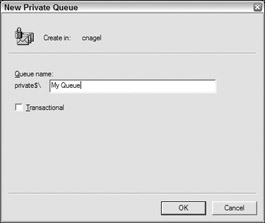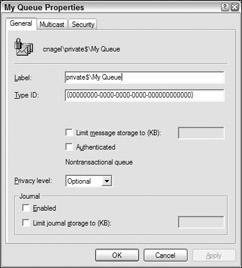Message Queuing Administrative Tools
Before looking at how to deal with Message Queuing programmatically, this section looks at the administrative tools that are part of the Windows operating system to create and manage queues and messages. The tools shown here are not only used with Message Queuing. The Message Queuing features of these tools are only available if Message Queuing is installed.
Creating Message Queues
Message queues can be created with the Computer Management MMC snap-in. On a Windows XP System you can start the Computer Management MMC snap-in with the Start Control Panel Administrative Tools Computer Management menu. In the tree view pane Message Queuing is located below the Services and Applications entry. By selecting Private Queues or Public Queues, new queues can be created from the Action menu (see Figure 31-5). Public queues are available only if Message Queuing is configured in Active Directory mode.

Figure 31-5
Message Queue Properties
After a queue is created, you can modify the queue's properties with the Computer Management snap- in by selecting the queue in the tree pane and selecting the Action Properties menu (see Figure 31-6).

Figure 31-6
Several options can be configured:
-
The label is the name of the queue that can be used to search for the queue.
-
The type id that is by default set to {} to map multiple queues to a single category or type. Report queues use a specific type id, as discussed earlier. A type id is a universal unique id (uuid) or GUID.
Note Custom type identifiers can be created with the uuidgen.exe or guidgen.exe utilities. uuidgen.exe is a command-line utility to create unique ids, and guidgen.exe is a graphical version to create uuids.
-
The maximum size of all messages of a queue can be limited to not fill up the disk. Message Queuing 2.0 had a limit of 2GB for the message store, which no longer exists with Message Queuing 3.0.
-
The Authenticated option can be checked to allow only authenticated users to write and read messages from the queue.
-
With the privacy level option, the content of the message can be encrypted. The possible values to set are None, Optional, or Body. None means that no encrypted messages are accepted, Body accepts only encrypted messages, and the default Optional value accepts both.
-
Target journaling can be configured with the journal settings. With this option, copies of the messages received are stored into the journal. The maximum size of disk space that is occupied can be configured for the journal messages of a queue. When the maximum size is reached, target journaling is ceased.
-
Message Queuing 3.0 has a new configuration option, Multicast, to define a multicast IP address for the queue. The same multicast IP address can be used with different nodes in the network, so that a message sent to a single address is received with multiple queues.
EAN: 2147483647
Pages: 351